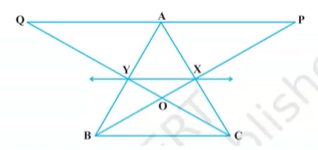In figure X and Y are the mid-points of AC and AB respectively, QP∣∣BC and CYQ and BXP are straight lines. Prove that ar(ΔABP)=ar(ΔACQ).

Given X and Y are the mid-points of AC and AB respectively. Also, QP∣∣BC and CYQ, BXP are straight lines.
To prove ar(ΔABP)=ar(ΔACQ)
Proof Since, X and Y are the mid-points of AC and AB respectively.
So, XY∣∣BC
We know that, triangles on the same base and between the same parallels are equal in area.
Here, ΔBYC and ΔBXC lie on same base BC and between the same parallels BC and XY.
So, ar(ΔBYC)=ar(ΔBXC)
On substracting ar(ΔBOC) from both sides, we get
ar(ΔBYC)−ar(ΔBOC)=ar(ΔBXC)−ar(ΔBOC)
⇒ ar(ΔBOY)=ar(ΔCOX)
On adding ar(ΔXOY) both sides, we get
ar(ΔBOY)+ar(ΔXOY)=ar(ΔCOX)+ar(ΔXOY)
⇒ ar(ΔBYX)=ar(ΔCXY) ...(i)
Hence, we observe that quadrilaterals XYAP and YXAQ are on the same base XY and between the same parallels XY and PQ.
∴ ar(XYAP)=ar(YXAQ) ...(ii)
On adding Eqs. (i) and (ii), we get
ar(ΔBYX)+ar(XYAP)=ar(ΔCXY)+ar(YXAQ)
⇒ ar(ΔABP)=ar(ΔACQ) Hence proved.
Topper's Solved these Questions
Similar Questions
Knowledge Check
In △ABC, M,N and P are the mid-points of AB,AC and BC respectively. If MN=3cm,NP=3.5cm and MP=2.5cm, calculate BC,AB and AC.
ABC = 6 cm
AB = 7cm
AC = 5cmBBC = 6 cm
AB = 7cm
AC = 8cmCBC = 6 cm
AC = 7cm
AB = 5cmDnone of these
In Δ ABC, D is the mid-point of AB and P is any point on BC. If CQ∣∣PD meets AB and Q (shown in figure), then prove that
ar(ΔBPQ)=12ar(ΔABC).

View SolutionIn Figure O is the mid-point of aB and CD. Prove tat AC=BD and AC||BD.

View SolutionABCD is a square. E and F are respectively the mid-points of BC and CD. If R is the mid-point of EF, prove that ar(ΔAER)=ar(ΔAFR).

View SolutionP and Q are respectively the mid-points of sides AB and BC of a triangle ABC and R is the mid-point of AP, show that
ar(ΔPRQ) = 1/2 ar(ΔARC)
View SolutionIn the adjoining figure , we have X and Y are the mid - point of AC and BC and AX = CY . Show that AC =BC.

View SolutionIf the given figure , M, N and P are the mid-points of AB,AC and BC respectively. If MN=3 cm, NP=3.5 cm and MP=2.5 cm, calculate BC , AB and AC

View SolutionD and E are points on sides AB and AC respectively of ΔABC such that ar(ΔDBC) = ar(ΔEBC). Prove that DE I I BC.
View Solution
